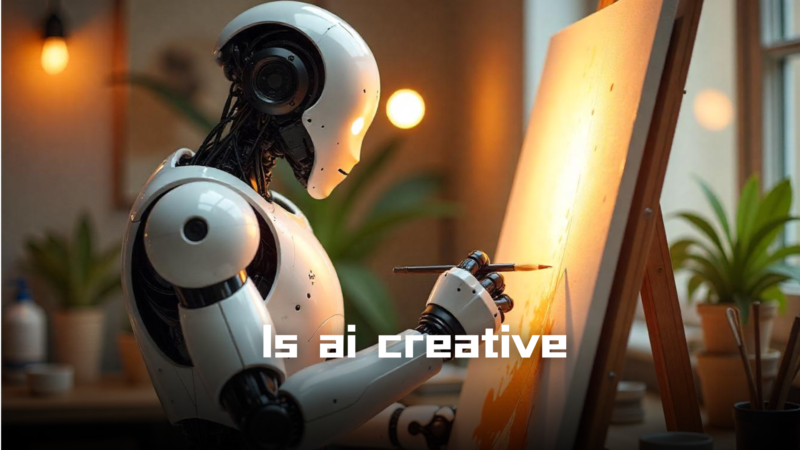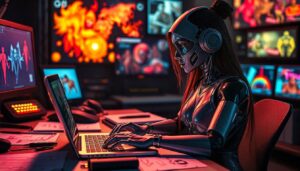Is ai creative

Is ai creative
AI and Creativity: Can Machines Really Write, Paint, or Compose Music?
Artificial Intelligence has advanced significantly over the past few years, revolutionizing health care, financial sectors, and so on and so forth. Yet, the realm that continues to fire the public imagination is AI’s prospects in creative domains-art, music, and literature. All new algorithms and machine learning models have challenged what was at one time considered exclusively human ingenuity’s zone. These are no longer just ideas: AI-generated art, music, and writing are real, now happening at an alarming rate.
This blog post will take a look at how the arts are being created using AI, investigate some of the more popular programs in use today, like OpenAI’s GPT models, Google’s Deep Dream, and other revolutionary tools, and then probe the deeper philosophical underpinnings of this trend of using AI-generated creativity. Are machines creative, or are they only imitating human creativity?
The Rise of AI-Generated Creativity
Creativity once was a feature uniquely human-an elusive, emotional, intuitive, and experiential process. Now AI systems can create original artworks, compose complex music, and write stories or poems. These new innovations fueled the excitement and the debate of what AI ought to be allowed to do in creative domains.
Among the most impressive AI innovations propelling this trend are
- As OpenAI’s GPT, the models, especially GPT-3 and GPT-4, write essays and poetry as much as they write fiction or dialogues. In short, the data on which these models are trained enables them to understand and replicate different writing styles and genres of text. It is possible for a user to give it a prompt and come up with everything from short stories to highly technical articles, which may sound almost convincingly human. In fact, the maturity of AI- generated writing sometimes makes it highly difficult to distinguish from writings produced by real authors.
- Google’s DeepDream The DeepDream computer vision program is a surreal and psychedelic image generator, developed by Google, using deep learning algorithms. Analyzing an image and then amplifying the patterns it finds gives amazing-and sometimes bizarre-interpretations of an original image. This has proven to be a very popular tool for abstract digital art generation, even though the images typically lack intentional meaning: Are AI systems tapping in to visual creativity?.
- AIVA stands for Artificial Intelligence Virtual Artist. It is an AI composing its own original music in a pretty wide range of genres: from the classical, jazz, to pop. AIVA composed a soundtrack for some movie, video games, and ads. It is truly impressive what this AI is able to create – musically rich music, which transforms the notion that only human life experience can produce deep emotion in music.
- DALL·E and CLIP DALL·E and CLIP are models developed by OpenAI and illustrate the ability of AI to generate detailed images from textual descriptions. These show an ability to create unique, imaginative visual art through complex human directions rather than human-driven artistic direction.
How AI Creates Art, Music, and Literature
The next step towards understanding exactly how AI can indeed generate creative outputs is understanding how these systems work. At its heart, machine learning is what makes AI creative-an AI model first trained on massive datasets to identify patterns then create new content.

- Data-Driven Creation What they do learn is from existing datasets. So, whether it’s written works, paintings, or musical scores, an AI model uses thousands (or millions) of examples for training to learn patterns, styles, and structures connected with a given type of creative work. A trained AI is capable of generating new pieces that reflect a learned style. Thus, GPT-4 will write in the Shakespeare style, and AIVA will compose a symphony, shaped much like the greatest works by Beethoven.
- Algorithmic Creativity Whereas the human thinks about experience, intuition, and emotion when being creative, the AI thinks in algorithms to create. In other words, the AI doesn’t “feel” creativity; it instead processes data using patterns to come up with something new. For example, in literature, the AI might predict what word or sentence comes next on the basis of statistical probabilities rather than inspiration. Similarly, AI in composition uses mathematical models to create sonically pleasing compositions, but the system does not “live through” the emotional journey of composing music.
- Generative Adversarial Networks GANs is another kind of AI that plays a vital part in the process of AI-generated art. GANs are two networks collaborating in the form of a generator and a discriminator that pushes each other towards producing images of the highest possible quality. The generator creates new images, and then proceeds to validate against what the discriminator tests as real or AI-created. Throughout this process, it improves the efficiency of the generator to become more realistic image producers.
Philosophical Implications: Can AI Ever Be Creative?
Looking at the emergence of creativity from machines, one may ask: can machines ever be creative, or merely mimic human creativity?
- Mimicry Over Creativity
One of the leading arguments that runs against AI creativity is that a machine can only make copies of the creativity that has been taught to it; artificial intelligence lacks personal experiences and emotions in the way that humans do, nor is it self-aware—two things that are often regarded as constituents of human creativity. For example, while an AI composer like AIVA can actually compose an original piece of music, doing so is the result of reproducing patterns learned from other compositions that already exist. Critics argue that nothing about an AI’s creative process—the lack of emotion, lack of intent, or subjective experience—makes it create creatively or innovatively like its human counterparts. - Can AI Have Intent?
Another core issue is the concept of intent. People writers typically have something they intend to do by writing-themes, plots, ideas-but AI just writes content as dictated by its algorithms where it doesn’t know what its writing about or why it is creating something. It has no intent, no emotional reason, and no understanding of what meaning there might be in the things it creates. - The Human in the Loop
Many AI creations are still limited by human control, as humans first provide the prompt or direction that the AI is to follow. For example, a person might tell DALL·E to generate a specific image based on a description, or a musician may use some AI-generated beats to fill in tracks of their own work. In this, AI serves as a tool amplifying human creativity instead of its own creative force. According to them, creativity only arises at the crossover point between human and machine. It cannot just be labeled as pure creativity of the machine. - Redefined Creativity
As it continues to blur the lines between machine output and artistic expression, a few will suggest that we redefine creativity in the face of AI. Does it constitute creativity the fact that AI can produce aesthetically pleasing or emotionally evocative works in ways that do not necessarily involve actually experiencing those emotions? Maybe AI creativity is only a form that differs in kind, operating on the points of algorithmic possibility but still producing valuable and original results.
Future of AI in Creative Sphere
AI, in many ways, is developing towards playing a more prominent role in creative industries. AI is sometimes applied and still applied as a complementary aspect rather than a substitute for human creativity. For instance, a musician might come up with beats initially created by an AI. The artist might use AI to experiment on a new visual style. Even a writer might get inspired by text produced by an AI for writing his or her work. The creative process is changing, but AI is improving it, and the completion of a human thought never replaces the touch and feel.
- Co-Creation with AI Many artists and content creators believe that the best change AI brings with itself is the chance to make something co-creatively better-than-they-can-be or do better than they could independently. This is because humans can assume some steps, patterns, or even styles yielded by the machine as inspiration and correct them to be aligned with what they envision for their output. It could simply be the start of a new form of creativity not there without the presence of AI.
- Seen rather as a collaborative creative, many in the creative industry are embracing AI. AI can take on repetitive work, quickly throw out ideas, and begin to point out patterns that may not have even occurred to the human brain. All of which would therefore allow their time to be devoted toward the emotional and interpretive aspects of their creativity.
Conclusion: The Changing Scenario of Creativity
The resultant, AI-created creativity, though still very nascent, betrays obvious signs of machines writing, painting, and even composing music—but philosophic implications remain contentious. Be that creative or just a tool that mimics human ingenuity, the ability of AI to dramatically change the face of art, music, and literature is undeniable.
Creativity is most certainly one field where, in the future, things are bound to take quite a leap with the development of AI. Instead of rendering the human artist obsolete, AI will continue to augment and expand what human beings can create. The future of creativity may well be interspliced with the imagination, creativity, and artificial intelligence cultures of the two, which should give each collaborator unique strengths in the creative process.
Important Link
- How did Kris Kristofferson die
- How to sign in bank of America online
- Millie Bobby Brown and Jake Bongiovi: A Love Story for the Ages
- India Women vs South Africa Women Cricket Match 2024
- Is Iran attacking Israel
- What happened to John Amos
- How many leagues are there in sports
- What are sports leagues
- How many times India beat Bangladesh?
Disclaimer: chronobazaar.com is created only for the purpose of education and knowledge. For any queries, disclaimer is requested to kindly contact us. We assure you we will do our best. We do not support piracy. If in any way it violates the law or there is any problem, please mail us on chronobazaar2.0@gmail.com
